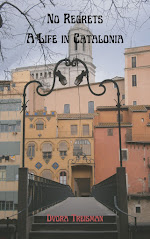I’ve been meaning to post something for a long time, but
somehow it hasn’t happened. However, today I got inspired. What is written
below wasn’t written by me, I’ve just typed it up from the book I happen to be
reading. The book is
Letter from New York
by Helene Hanff. It is a collection of beautifully written short essays that
she wrote monthly, years ago, for the BBC Radio program “Woman’s Hour.” This
one, from March 1981, seems particularly apropos today.
March 1981
I wish to enlist your sympathy for the poor millionaires who
live on Fifth Avenue, in New York’s most expensive town houses and co-op
apartments. With the coming of the warm months, they’re braced for a long
succession of parades up Fifth Avenue, Sunday after Sunday.
These parades are ethnic. Take the Pulaski Day and von
Steuben Day parades, in honour of European generals who fought in our War of
Independence. Pulaski was a Pole, von Steuben was German, so the Pulaski Day
parade is organized by Polish New Yorkers, the von Steuben Day parade by German
New Yorkers. There are parades on Greek Independence Day, Puerto Rico Day,
Salute to Israel Day, Philippine Independence Day, and so forth, including
Captive Nations Day for Armenian, Bulgarian, Czech, Hungarian, Lithuanian and
Romanian New Yorkers.
All these parades go straight up Fifth Avenue, which means
that at 8 a.m. of a spring Sunday the occupants of a town house are wakened by
the boom-boom of the drum and the raucous blare of a trumpet, as the first
marching band tunes up under their windows. It will be followed by twenty more
marching bands and the millionaires will get no peace for the rest of the day.
The millionaires formed Community Action Groups and demanded
that the city issue parades permits only for weekdays. But this was fought by
Fifth Avenue merchants, since parade crowds impede shoppers and are bad for
business. So the millionaires demanded that the city move its Sunday parades to
some other Avenue. This, the city could not do. You can’t give one ethnic group
the right to march up Fifth Avenue and tell all other groups to march somewhere
else.
When a century ago the first ethnic groups held a parade, it
had its right to use Fifth Avenue written into the City Charter. That group
still holds the city’s biggest and most popular parade, popular even with the
millionaires since it’s never on a Sunday. The parade is held on March 17th,
and when that falls on a Sunday it’s held on the 18th because the
parade is in honour of St Patrick’s Day, with a reviewing stand in front of St
Patrick’s Cathedral.
St Patrick’s Day is unique in New York; for some reasons
known to nobody, on March 17th the entire city becomes Irish. But I
have to tell you about the one never-to-be-forgotten St Patrick’s Day, back in
the Sixties.
New York has always had a large Irish Catholic population
and a small Irish Protestant population. But one year in the Sixties the Mayor
of Dublin, Robert Briscoe, was to be guest of honour at the St Patrick’s Day
parade and the newspapers announced that Robert Briscoe was not an Irish
Catholic, nor yet an Irish Protestant, but – Heaven bless us – an Irish Jew. I
mean to tell you, the Jewish population of New York went completely out of its
mind.
Cohen’s clothing store and Goldberg’s Meat Market painted
green O-aposrophes on their signs and became O’Cohen’s and O’Goldberg’s for the
day. Delicatessens sold green bagels, kosher restaurants served green
matzoh-balls and green noodles in their soup. Whole Hebrew schools turned out
for that parade as the annual sea of green floats, marching bands, and
schoolgirls in green shorts rolled past the Cathedral, before the three
dignitaries on the reviewing stand: Jewish Mayor Briscoe of Dublin and
Protestant Mayor Lindsay of New York, with the Catholic Cardinal between them.
Well, this year’s St Patrick’s Day parade has just come and
gone and the long Sunday parade season looms ahead. Which brings us back to the
millionaires. Why do they put up with it? Why don’t they move?
They’ll keep fighting to have the parades moved to some
other day or some other Avenue. But they know that those ethnic parades, which
would be unimaginable in any other great city in the world, are the essence of
this one, the visible signs of that melting pot out of which New York was
created. They know it, because millionaires, too, are descended from poor
immigrants, beckoned here by the Statue in the harbour, holding out hope of a
better life. So the millionaires and the marchers are all kin – all New Yorkers
– like the rest of us.
























